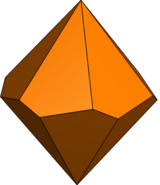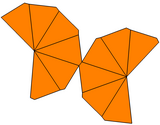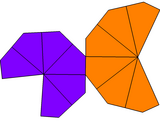Trapezohedron
| Set of dual-uniform n-gonal trapezohedra | |
|---|---|
 Example dual-uniform pentagonal trapezohedron | |
| Type | dual-uniform in the sense of dual-semiregular polyhedron |
| Conway notation | dAn |
| Schläfli symbol | { } ⨁ {n}[1] |
| Coxeter diagrams | |
| Faces | 2n congruent kites |
| Edges | 4n |
| Vertices | 2n + 2 |
| Face configuration | V3.3.3.n |
| Symmetry group | Dnd, [2+,2n], (2*n), order 4n |
| Rotation group | Dn, [2,n]+, (22n), order 2n |
| Dual polyhedron | (convex) uniform n-gonal antiprism |
| Properties | convex, face-transitive, regular vertices[2] |
An n-gonal trapezohedron, antidipyramid, antibipyramid, or deltohedron is the dual polyhedron of an n-gonal antiprism. The 2n faces of an n-trapezohedron are congruent and symmetrically staggered; they are called twisted kites. With a higher symmetry, its 2n faces are kites (also called trapezoids, [citation needed] or deltoids).
The n-gon part of the name does not refer to faces here, but to two arrangements of each n vertices around an axis of n-fold symmetry. The dual n-gonal antiprism has two actual n-gon faces.
An n-gonal trapezohedron can be dissected into two equal n-gonal pyramids and an n-gonal antiprism.
Name
These figures, sometimes called deltohedra, must not be confused with deltahedra, whose faces are equilateral triangles.
A twisted trigonal trapezohedron (with six twisted trapezoidal faces) and a twisted tetragonal trapezohedron (with eight twisted trapezoidal faces) exist as crystals; in crystallography[3] (describing the crystal habits of minerals), they are just called trigonal trapezohedron and tetragonal trapezohedron. They have no symmetry plane, and no symmetry center. The trigonal trapezohedron has one 3-fold symmetry axis, perpendicular to three 2-fold symmetry axes.[4] The tetragonal trapezohedron has one 4-fold symmetry axis, perpendicular to four 2-fold symmetry axes.[4]
Also in crystallography, the word trapezohedron is often used for the polyhedron with 24 trapezoidal faces properly known as a (deltoidal) icositetrahedron.[5] Another polyhedron, with 12 trapezoidal faces, is known as a deltoid dodecahedron.[6]
Symmetry
The symmetry group of an n-gonal trapezohedron is Dnd, of order 4n, except in the case of n = 3: a cube has the larger symmetry group Od of order 48 = 4×(4×3), which has four versions of D3d as subgroups.
The rotation group of an n-trapezohedron is Dn, of order 2n, except in the case of n = 3: a cube has the larger rotation group O of order 24 = 4×(2×3), which has four versions of D3 as subgroups.
One degree of freedom within symmetry from Dnd (order 4n) to Dn (order 2n) changes the congruent kites into congruent quadrilaterals with three edge lengths, called twisted kites, and the n-trapezohedron is called a twisted trapezohedron. (In the limit, one edge of each quadrilateral goes to zero length, and the n-trapezohedron becomes an n-bipyramid.)
If the kites surrounding the two peaks are not twisted but are of two different shapes, the n-trapezohedron can only have Cnv (cyclic with vertical mirrors) symmetry, order 2n, and is called an unequal or asymmetric trapezohedron. Its dual is an unequal n-antiprism, with the top and bottom polygons of different radii.
If the kites are twisted and are of two different shapes, the n-trapezohedron can only have Cn (cyclic) symmetry, order n, and is called an unequal twisted trapezohedron.
| Trapezohedron type | Twisted trapezohedron | Unequal trapezohedron | Unequal twisted trapezohedron | |
|---|---|---|---|---|
| Symmetry group | D6, (662), [6,2]+ | C6v, (*66), [6] | C6, (66), [6]+ | |
| Polyhedron image | 
|

|

|

|
| Net | 
|

|

|

|
Forms
An n-trapezohedron has 2n quadrilateral faces, with 2n+2 vertices. Two apexes are on the polar axis, and the other vertices are in two regular n-gonal rings of vertices.
| Trapezohedron name | Digonal trapezohedron (Tetrahedron) |
Trigonal trapezohedron | Tetragonal trapezohedron | Pentagonal trapezohedron | Hexagonal trapezohedron | ... | Apeirogonal trapezohedron |
|---|---|---|---|---|---|---|---|
| Polyhedron image | 
|

|

|

|
... | ||
| Spherical tiling image | 
|

|

|

|

|
Plane tiling image | |
| Face configuration | V2.3.3.3 | V3.3.3.3 | V4.3.3.3 | V5.3.3.3 | V6.3.3.3 | ... | V∞.3.3.3 |
Special cases:
- n = 2. A degenerate form of trapezohedron: a geometric tetrahedron with 6 vertices, 8 edges, and 4 degenerate kite faces that are degenerated into triangles. Its dual is a degenerate form of antiprism: also a tetrahedron.
- n = 3. The dual of a triangular antiprism: the kites are rhombi (or squares); hence these trapezohedra are also zonohedra. They are called rhombohedra. They are cubes scaled in the direction of a body diagonal. They are also the parallelepipeds with congruent rhombic faces.

A 60° rhombohedron, dissected into a central regular octahedron and two regular tetrahedra - A special case of a rhombohedron is one in which the rhombi forming the faces have angles of 60° and 120°. It can be decomposed into two equal regular tetrahedra and a regular octahedron. Since parallelepipeds can fill space, so can a combination of regular tetrahedra and regular octahedra.
Examples
- Crystal arrangements of atoms can repeat in space with trigonal and hexagonal trapezohedral cells.[7]
- The pentagonal trapezohedron is the only polyhedron other than the Platonic solids commonly used as a die in roleplaying games such as Dungeons & Dragons. Having 10 sides, it can be used in repetition to generate any decimal-based uniform probability desired. Two dice of different colors are typically used for the two digits to represent numbers from 00 to 99.
Star trapezohedron
A face-transitive star p/q-trapezohedron is defined by a regular zig-zag skew star 2p/q-gon base, two symmetric apexes with no degree of freedom right above and right below the base, and kite faces connecting each pair of base adjacent edges to one apex.
Such a star p/q-trapezohedron is a self-intersecting, crossed, or non-convex form. It exists for any regular zig-zag skew star 2p/q-gon base; but if p/q < 3/2, then p — q < q/2, so the dual star antiprism (of the star trapezohedron) cannot be uniform (i.e.: cannot have equal edge lengths); and if p/q = 3/2, then p — q = q/2, so the dual star antiprism must be flat, thus degenerate, to be uniform.
A dual-uniform star p/q-trapezohedron has Coxeter-Dynkin diagram ![]()
![]()
![]()
![]()
![]()
![]()
![]() .
.
| 5/2 | 5/3 | 7/2 | 7/3 | 7/4 | 8/3 | 8/5 | 9/2 | 9/4 | 9/5 |
|---|---|---|---|---|---|---|---|---|---|

|

|
||||||||
| 10/3 | 11/2 | 11/3 | 11/4 | 11/5 | 11/6 | 11/7 | 12/5 | 12/7 |
|---|---|---|---|---|---|---|---|---|
Dodecagonal trapezohedron
A dodecagonal trapezohedron is a trapezohedron with 24 kites. It has 12-fold antiprismmic symmetry, order 48.
See also
- Diminished trapezohedron
- Rhombic dodecahedron
- Rhombic triacontahedron
- Bipyramid
- Truncated trapezohedron
- Conway polyhedron notation
- The Haunter of the Dark, a short story by H.P. Lovecraft in which a fictional ancient artifact known as The Shining Trapezohedron plays a crucial role.
References
- ^ N.W. Johnson: Geometries and Transformations, (2018) ISBN 978-1-107-10340-5 Chapter 11: Finite symmetry groups, 11.3 Pyramids, Prisms, and Antiprisms, Figure 11.3c
- ^ "duality". maths.ac-noumea.nc. Retrieved 2020-10-19.
- ^ Spencer 1911, pp. 569–591.
- ^ a b Spencer 1911, p. 581, fig 74.
- ^ Spencer 1911, p. 574, fig 17.
- ^ Spencer 1911, p. 575, fig 27.
- ^ Trigonal-trapezohedric Class, 3 2 and Hexagonal-trapezohedric Class, 6 2 2
- Anthony Pugh (1976). Polyhedra: A visual approach. California: University of California Press Berkeley. ISBN 0-520-03056-7. Chapter 4: Duals of the Archimedean polyhedra, prisma and antiprisms
- Spencer, Leonard James (1911). . In Chisholm, Hugh (ed.). Encyclopædia Britannica. Vol. 07 (11th ed.). Cambridge University Press. pp. 569–591.
External links
- Weisstein, Eric W. "Trapezohedron". MathWorld.
- Weisstein, Eric W. "Isohedron". MathWorld.
- Virtual Reality Polyhedra The Encyclopedia of Polyhedra
- VRML models (George Hart) <3> <4> <5> <6> <7> <8> [permanent dead link] <9> <10>
- Conway Notation for Polyhedra Try: "dAn", where n=3,4,5... Example: "dA5" is a pentagonal trapezohedron.
- Paper model tetragonal (square) trapezohedron

